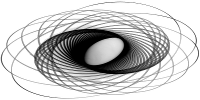S. Liu, R. R. Martin, F. C. Langbein, P. L. Rosin. Segmenting Periodic Reliefs on Triangle Meshes. In: R. R. Martin, M. A. Sabin, J. J. Winkler (eds), Maths of Surfaces XII, Springer LNCS, 4647:290-306, 2007. [DOI: 10.1007/978-3-540-73843-5_18] [PDF]
Decorative reliefs are widely used for e.g. packaging and porcelain design. In periodic reliefs, the relief repeats a pattern, for example all the way around an underlying surface of revolution. Reverse engineering of existing reliefs allows them to be re-applied to different base surfaces; we show here how to segment a single repeat unit of a periodic relief starting from a scanned triangle mesh. We first briefly review how we segment the relief from the background surface using our previous work. The rest of the paper then concentrates on how we extract a single repeat unit from the relief. To do so, the user provides two points on one relief boundary which are in approximate correspondence on consecutive repeats of the relief. We first refine the relative locations of these points, and then determine a third corresponding point using relief boundary information. These are used to determine three initial cutting planes across the relief. Then surface registration strategies are utilised to refine the correspondence between adjacent repeat units. Finally, we refine the exact locations of the cutting planes by considering only surface information close to the cutting planes. This allows a repeat unit of the periodic relief to be extracted. We demonstrate that our algorithm is successful and practical, using various real scanned models: user input can be quite imprecise, and we can cope with hand-made reliefs in which the pattern units are only approximately copies of each other.
![]() This work is licensed under a Creative Commons Attribution-NonCommercial-ShareAlike 4.0 International License.
This work is licensed under a Creative Commons Attribution-NonCommercial-ShareAlike 4.0 International License.

